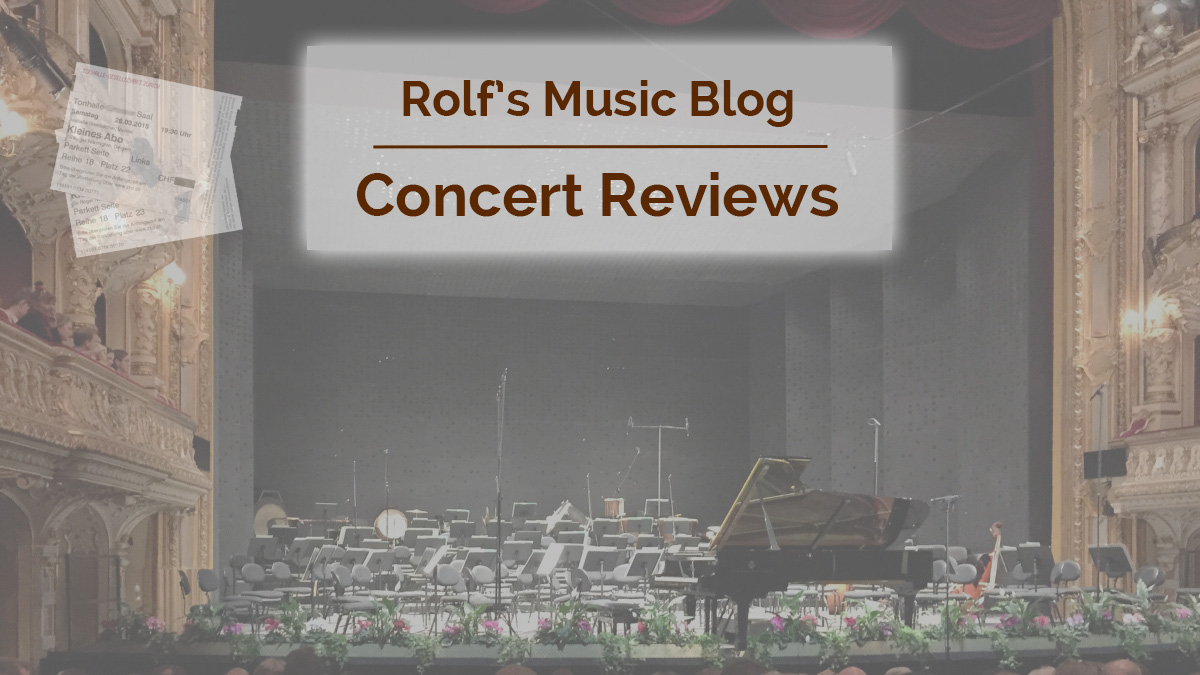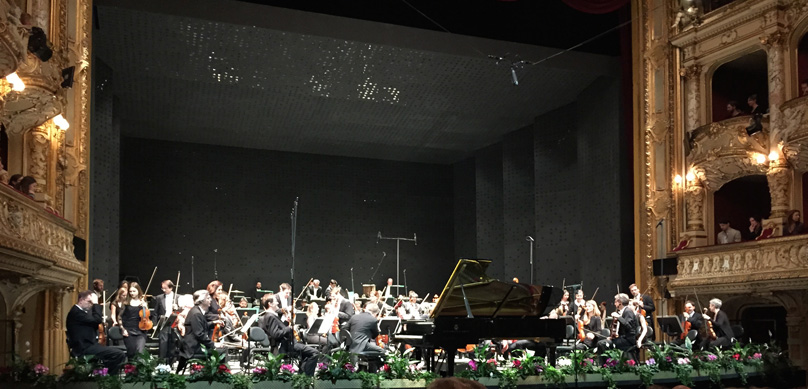Rachmaninoff: Piano Concerto No.3 D minor, op.30
Mahler: Symphony No.5 in C♯ minor
Zurich Opera House, 2015-01-18

2015-01-21 — Original posting
2015-07-04 — Added links for music scores
2016-08-01 — Brushed up for better readability
Table of Contents
Introduction
This was the fourth Philharmonic Concert at Zurich Opera in this season. The Orchestra—as in all Philharmonic Concerts, was the Philharmonia Zürich, the orchestra of the Zurich Opera House. The conductor was its director, Fabio Luisi.
At the same time, this turned out to be the 30th anniversary of the orchestra. 30 years ago, the joint “Tonhalle- und Theater-Orchester Zürich” (serving the Zurich Opera House and the Tonhalle Zürich) was split into two independent entities. So, the Tonhalle Orchestra Zurich is also looking back to 30 years of performances in its current form. Three years ago, the part serving the Opera House assumed the new name “Philharmonia Zürich”.
In this concert, the young French pianist Lise de la Salle joined the orchestra. Lise de la Salle is “artist in residence” with the Philharmonia Zürich for the seasons 2013 – 2015. She is performing all four piano concertos by Rachmaninoff during these two seasons. I have attended the concert in December 2013, in which she performed the Concerto No.2 in C minor, op.18. See my brief, cursory review “Concert at Zurich Opera House, 2013-12-22” on this.
Sergei Rachmaninoff (1873 – 1943): Piano Concerto No.3 in D minor, op.30
The first part of this evening consisted of Rachmaninoff’s Piano Concerto No.3 in D minor, op.30. That’s a well-respected benchmark among pianists of the top league. Lise de la Salle played this concerto eloquently, with compassion. She visibly lived with the music, also in the orchestral parts. Her playing is fluent, competent, aimed at a full, round sound rather than the ultimate transparency. The articulation in general felt rather legato and with plenty of sustain pedal. Maybe in parts she was trying to compensate the dry acoustics of the venue? Interestingly, the score does not include any indications regarding the use of pedals at all.
I. Allegro ma non tanto
At the start of the first movement, Fabio Luisi selected a moderate tempo. Yet, this appeared to be faster than what Lise de la Salle liked to use, so she started slowing down in the third bar, when the piano introduces the first theme. That theme carries the annotation commodo (sic!) in the piano part. However, that can’t apply to the tempo, but merely to the character, the articulation of the theme. It likely indicates that it should appear in a “leisurely”, more passive, less engaged attitude. The indication commodo would appear on all voices if the orchestra were to follow. With this initial slowdown, I found it a pity that the passage lost its somewhat feverish character.
One might argue that the score does not mention “feverish”, i.e., that it should be allowed for this passage to be played with a different character. However, that theme returns in the movement, both in the orchestra, as well as twice in the piano part:
- once in the middle of the movement, softened and modulating to B♭ major, and
- then again in the original form, close to the end of the movement.
Logically, these instances enforce a return to that slow(er) tempo. In this concert, I found both transitions to the slower tempo somewhat unnatural, enforced. Plus, the last instance defeated all the momentum that was built up in the extremely virtuosic cadenza, and only part of that forward drive could be regained in the last bars.
The cadenza was the (now) standard version, not the original (now “ossia“) one. The latter has the same length, but is even more difficult to play.
II. Intermezzo: Adagio
Indeed, the base pace was calm (= Adagio) in the second movement with the annotation Intermezzo: Adagio. I was glad to see that the conductor did not see this as an opportunity for overblown emotions. He left the movement in a mostly serene, sometimes playful atmosphere. That said: the movement does have its challenges, the solo part is often very virtuosic, even with plenty of opportunities for “keyboard thunderers”. It’s very demanding, overall: around [27] in the score, the rhythm in the top voice wasn’t always quite accurate.
III. Alla breve
The biggest technical challenges for the soloist in this concerto are found in the last movement. One could sense that from a slight degrading in rhythmic conciseness and precision. The orchestra under Fabio Luisi was a very attentive accompanist, very precise in general, even through the rhythmic intricacies of the più mosso section with its “pseudo-syncopation” in the piano. Yes, the acoustics in the opera house were dry, as usual. Strangely, there were times when the low brass registers in the back of the stage partially covered the bass register in the piano.
Encore: Bach-Busoni
The audience was enthusiastic, and so, Lise de la Salle announced an encore: “Un petit choral de Bach”. This turned out to be “Ich ruf’ zu dir, Herr Jesu Christ“, BWV 639 (I call to You Lord Jesus Christ) by Johann Sebastian Bach (1685 – 1750), in a transcription for the piano (BV B 27/5) by Ferruccio Busoni (1866 – 1924). I’m almost 100% certain that it’s the same encore as for Rachmaninoff’s Piano Concerto No.2 in December 2013 — even the wording of the announcement was the very same!
A spontaneous coincidence, or an accident by neglect? Maybe the soloist thinks this is a good fit as encore to any Rachmaninoff? I’d vote for the latter: it was indeed fitting well, and both the pianist and the audience deserved enjoying the contemplative solemnity of this chorale after all the excitement of the preceding concerto. I just hope she did not play that very same encore with all of the concerti?
Gustav Mahler (1860 – 1911): Symphony No.5 in C♯ minor
The biggest part of the evening, after the intermission, was devoted to Gustav Mahler and his Symphony No.5 in C♯ minor. This composition was completed five years before Rachmaninoff’s concerto. However, the two compositions have an interesting link insofar as Mahler conducted the second performance of Rachmaninoff’s concerto (with the composer at the piano) in the United States, shortly after the composer had played the world premiere of his work (also in the States).
I. Trauermarsch. In gemessenem Schritt. Streng. Wie ein Kondukt
Fabio Luisi proved to be an attentive reader of Mahler’s notation. A score which defines the music and its performance down to the smallest detail in articulation, for any instrument, sometimes even telling the conductor what movements to make. Today, we would call the composer an “extreme control freak”! Such detail started in the first bars, where the triplets in the trumpet signal sounded somewhat rushed, superficial, “as in military fanfares” — and that’s exactly the way Mahler specified it in the score. Luisi’s meticulous score reading continued in the detailed dynamic annotations in the score.
With all that detail, though, Mahler did not specify metronome numbers for the tempo. On top of that, he rarely used standard tempo annotations, such as Allegro, Andante, Adagio. He rather used his own, German wording to describe the tempo. For example, in the first movement: “In gemessenem Schritt. Streng. Wie ein Kondukt” (in measured pace, strict, like a funeral procession). OK, but how fast is a funeral procession? How fast were funeral processions at Mahler’s time, in the Austro-Hungarian Empire? In Luisi’s interpretation, the tempo for the funeral march was at the lower limit, but could still be seen as a slow marching pace. Funerals at the turn to the 20th century were not the same as modern State funerals!
Where Mahler writes “Plötzlich schneller. Leidenschaftlich. Wild” (suddenly faster, passionate, wildly), Luisi plays out verve, passion and emphasis. In Mahler’s composition, this is merely an episode, a passionate upheaval. After this, the funeral procession resumes its course, up to those wonderfully comforting, descending sixths close to the end, into which the trumpet signal from the beginning twice reminds us of the inevitability of death.
II. Stürmisch bewegt, mit größter Vehemenz
The second movement is initially annotated “Stürmisch bewegt, mit größter Vehemenz” (moving impetuously, with utter vehemence). It is a mix of virtuosic, polyphonic, almost chaotic sections and more contemplative, almost vocal scenes, which allowed cellos and violas to expose the warm, full sound of their instruments. Towards the end, after another, lengthy eruption, the movement gradually retracts into an ending in the somber mood of the initial funeral march scenery. My main question mark here is in a slow-down at [2] in the score, which Mahler does not mark at all. There is a similar passage with slow-down mark, close to the end (after [20]), but I don’t think one ought to treat these two instances the same way. It is unlikely that Mahler forgets such an annotation.
III. Scherzo
The following Scherzo, Mahler annotated “Kräftig, nicht zu schnell” (vigorously, not too fast), later also “Nicht eilen” (don’t rush). Here, the tempo sounded so moderate and relaxed that the movement lost its grotesque, bizarre aspects. On top of that, when Mahler writes “Etwas ruhiger” (somewhat calmer), this translated into a very noticeably slower pace. Even just because of the bone-dry acoustics of the venue, a faster tempo would have been desirable, if not necessary. There are some passages with small brass and woodwind ensembles that (to me) evoked the impression of a lonely country band out in the province, playing on an empty village square.
IV. Adagietto
The Adagietto — a music maybe too well-known altogether? This was played at the lower tempo limit, probably fulfilling expectations for dreamy, sublime music, interpreted rather in the spirit of a soul longing for death. Luckily, with the exception of two intended / composed outbursts in the strings, the piece was not effusive or overblown, but remained subtle. Still, it could hardly be felt as Mahler’s love declaration for Alma that it was really meant to be. With a faster tempo, the piece would not necessarily lose intensity, and this also would avoid over-stretching the melodies.
V. Rondo-Finale
A real artistic firework evolves in the concluding Rondo-Finale. That’s a showpiece for polyphonic virtuosity in the orchestra. It was really well-played by the orchestra, without aiming at unnecessary ultra-polished perfection. The occasional coordination issues (and surely also the mishap in the horn at the worst moment, in the transition to the Allegro giocoso) must have been the consequence of the substantial physical demands of the long evening. Plus, the opera house had also produced Mozart’s “Le Nozze di Figaro” in the afternoon of the same day!
Conclusion
Overall, it was definitely an enriching, gratifying concert experience — congratulations to the orchestra on the occasion of its 30th anniversary!
Addendum 1
Scores are available for the works in this concert:
- For Rachmaninoff’s Piano Concerto No.3, op.30 I have used the pocket score by Boosey & Hawkes —Find pocket score on amazon.com (#ad) —
- Mahler’s Symphony No.5 is found in the Eulenburg pocket score —Find pocket score on amazon.com—
Addendum 2
I have written separate CD reviews with more in-depth coverage of the composition for the works in this concert :
For a short & cursory review of the preceding concert in the series with Lise de la Salle playing Rachmaninoff’s piano concertos see “Concert at Zurich Opera House, 2013-12-22“.
Addendum 3
For the same concert, I have also written a (much shorter) review in German for Bachtrack.com. This posting is not a translation of that German review, the rights of which remain with Bachtrack. I create the German review using a subset of the notes taken during this concert. I wanted to enable my non-German speaking readers to read about my concert experience as well. Therefore, I have taken my original notes as a loose basis for this separate posting. I’m including additional material that is not present in the Bachtrack review.




